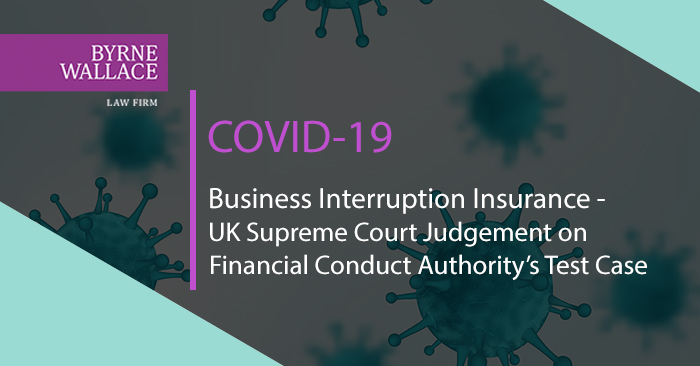Business Interruption Insurance - UK Supreme Court Judgment on Financial Conduct Authority’s Test Case
Wednesday, 20 January 2021
On 15 January 2021, the UK Supreme Court delivered its much anticipated judgment on the Financial Conduct Authority’s (“FCA”) test case.
In a landmark decision affecting approximately 370,000 UK policyholders1, the Supreme Court found in favour of the FCA, and SME policyholders respectively, whilst unanimously rejecting the defendant insurers’ appeals from the High Court judgment.
This judgment materially broadens the cover which is available to UK policyholders for business interruption losses caused by COVID-19 and matters/circumstances inextricably linked to the pandemic.
It is expected that this judgment will be considered by the Irish High Court prior to delivering its decision in the proceedings commenced by policyholders against the insurance company, FBD. That judgment is due to be delivered by Justice McDonald on 5 February 2021.
If the UK Supreme Court’s reasoning on causation and trends clauses is adopted by the Irish High Court, it is expected that Irish policyholders will have strong claims for business interruption loss caused by the COVID-19 pandemic and its wider effects. In addition, the level of payments potentially due to Irish policy holders is also likely to be significantly higher than initially expected due to the UK Supreme Court’s interpretation of trends clauses.
This judgment is a welcome development for many struggling Irish SMEs in the retail, hospitality and leisure sectors who may have presented COVID-19 business interruption claims previously to their insurers but have been told that their claim was declined or may have had limited, if any, engagement from their insurer to date.
Businesses should now review their insurance policies again in light of these developments and take advice to establish whether their business interruption claim should be assessed more favourably by their insurers now.
We analyse below the recent UK Supreme Court judgment which addressed appeals (following the High Court judgment) advanced by the FCA, the Hiscox Action Group and six of the eight defendant insurers. We previously analysed the UK High Court judgment in our article of 18 September.
In its judgment, the Supreme Court categorised the issues being appealed as set out below:
The diseases clauses – interpretation
The Supreme Court largely agreed with the scope of cover provided by disease clauses. Namely, that disease clauses do not confine cover to business interruption resulting only from cases of COVID-19 within a specified area (as defined in any given policy) and that due consideration should be given to the potential for COVID-19 to affect a wide area.
The Supreme Court did however construct the disease clauses before it more narrowly than the High Court. Upon considering various policy wordings (in particular, RSA wording2), the Supreme Court concluded that only an occurrence within the specified area was an insured peril and not anything outside that area. The Court also considered that each individual case of COVID-19 constituted a separate occurrence and that the term “Notifiable Disease” is not the outbreak or disease itself, but the illness sustained by a person at a certain time and place.
However, because of the court’s agreement with the High Court on the scope of cover provided under such clauses and its approach to causation (see below), the disease clauses will still respond to interruption caused by the pandemic.
The prevention of access and hybrid (combining elements of disease and prevention of access) clauses – interpretation
In relation to the disease elements of the hybrid clauses, the Supreme Court reached the same interpretation as that for disease clauses mentioned above.
The Court made the following key findings for prevention of access and hybrid clauses:
- Whilst policy wordings such as “restrictions imposed by a public authority”, “closure or restrictions placed”, “enforced closure” etc. might connote measures imposed by a relevant authority which are legally mandatory, in practice, a restriction need not always refer to the exercise of legal powers. The appropriate test in interpreting the words used by a relevant authority would be how they were to be understood by a reasonable person. Of particular importance, was, whether the restriction imposed was in sufficiently clear and mandatory terms to enable a reasonable person to know with reasonable certainty what compliance was required.
- The Supreme Court upheld the High Court’s decision that a mere hindrance or impairment to the use of premises would not constitute an “inability to use” premises. However, the court made a significant finding that if a policyholder is “unable to use [its] premises for a discrete part of its business or if is unable to use a discrete part of its premises for its business activities3”, this is considered a complete inability to use a discrete part of the business premises, thereby triggering policy cover for related losses.
- The court made similar findings for “prevention” or “denial” of access policy wordings, namely that this means “stopping something from happening or making an intended act impossible4”, distinguishing it from a mere hindrance. The same qualification for policy cover and discrete parts of the premises also applied to these clauses.
- The court concluded the term “interruption” encompassed interference or disruption to a business which does not bring about a complete cessation of business or activities, and which may even be slight. Importantly, the court pointed out that this will only be relevant if it has a material effect of the financial performance on the business.
Causation
The defendant insurers have, to date, argued that for policy cover to be triggered it is necessary to show, at a minimum, that a policyholder’s loss would have not been sustained ‘but for’ the occurrence of the insured peril. Insurers have argued that the policies do not respond because the widespread nature of COVID-19 meant that an insured party would have suffered the same, or similar, business interruption losses even if the insured peril had not occurred.
The Supreme Court analysed the ‘but for’ test in detail and held that such a test was not determinative in concluding whether the test for causation had been satisfied.
Crucially, the court considered that there is nothing in the principle of causation which prevents an insured peril, which in combination with many other similar uninsured events, brings about a loss with a sufficient degree of inevitability from being regarded as a proximate cause of the loss. Whether the causal connection is sufficient to trigger policy cover and payment is dependent on what was agreed between a policyholder/insurer5.
For the clauses in issue, the court concluded that:
- For disease clauses, to show that loss was proximately caused by one or more occurrences of illnesses from COVID-19, it is sufficient to prove that the interruption was a result of Government action taken in response to cases of disease, which included at least one case of COVID-19 within the geographical area covered by the clause. This analysis is also relevant to those hybrid clauses which contain, as one element, a disease clause6.
- For prevention of access and hybrid clauses, the court considered that losses in this context would have occurred for a policyholder in any event because there are two equally effective causes: 1) the insured peril described in the policy and 2) the uninsured but not excluded pandemic and the socio-economic ramifications. The court pointed out that an insured must show that the insured peril is an equally effective cause of loss for indemnity to apply; if the sole proximate cause of loss was the pandemic itself, cover would not be triggered7.
Quantification of losses – trends clauses and pre-trigger losses
The judgment looked at trends clauses, reiterating that, absent wording to the contrary, insurers cannot reduce indemnity otherwise due to an insured on the basis that the losses were caused by other, uninsured (but not excluded) perils, the underlying cause of which was the pandemic. The Supreme Court stated that “the standard turnover or gross profit derived from previous trading is adjusted only to reflect circumstances which are unconnected with the insured peril and not circumstances which are inextricably linked with the insured peril, in the sense they have the same underlying or originate cause8”.
This approach ensures that trends clauses are construed in line with insuring clauses and does not take away cover otherwise provided by such clauses.
Separately, the court also considered pre-trigger losses, overturning the High Court’s conclusion. The Supreme Court held (in line with its position on the operation of trends clauses) that an indemnity should be calculated by reference to what would have been earned had there been no presence of COVID-19, having no regard for any revenue drop prior to the policy being triggered that resulted from the pandemic, or its wider effects.
The Orient Express decision
In line with its approach to causation and the interpretation of the trends clauses, the Supreme Court held that the Orient Express case was wrongly decided and overruled it.
In particular, the court applied its analysis of causation (see above) to the same facts present in the Orient Express case. It concluded that business interruption loss which arose because both (a) the hotel was damaged and also (b) the surrounding area and other parts of the city were damaged by the hurricanes had two concurrent causes, each of which was by itself sufficient to cause the relevant business interruption but neither of which satisfied the ‘but for’ test because of the existence of the other. It considered that where both the insured peril and the uninsured peril, which operates concurrently with it, arise from the same underlying fortuity (the hurricanes), then provided that damage proximately caused by the uninsured peril (i.e. in the Orient-Express case, damage to the rest of the city) is not excluded, loss resulting from both causes operating concurrently is covered9.
For further information, please contact Mark O’Shaughnessy, Partner, or Tanya Cotterell, Solicitor, from the ByrneWallace Litigation & Dispute Resolution Team or your usual ByrneWallace contact.
2 The RSA policy wording considered was where an insured peril was the “occurrence of a Notifiable Disease within a radius of 25 miles of the Premises”. The term “Notifiable Disease” was defined as an “illness sustained by any person resulting from… any human infectious or human contagious disease… an outbreak of which the competent local authority has stipulated shall be notified to them.”
3 Supreme Court judgment, para 137
4 Supreme Court judgment, para 151
5 Supreme Court judgment, para 191
6 Supreme Court judgment, para 212
7 Supreme Court judgment, paras 243/244
8 Supreme Court judgment, para 287
9 Supreme Court judgment, para 309

